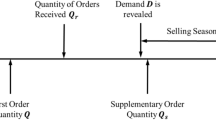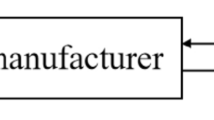Abstract
We consider a one-period two-echelon supply chain composed of a loss-averse supplier with yield randomness and a loss-averse retailer with demand uncertainty. At the beginning of the selling season, the retailer orders from the supplier via the wholesale price contract, and then the supplier makes his production decision. We derive the loss-averse retailer’s optimal ordering policy and the loss-averse supplier’s optimal production policy under these conditions. In addition, we discuss the effect of loss aversion on both parties’ decision making and show how loss aversion contributes to decision bias. Furthermore, we find that the loss-averse retailer’s optimal order quantity may increase in wholesale price and decrease in retail price which is differ from the risk-neutral case where the optimal order quantity is always decreasing in wholesale price and increasing in retail price. Finally, numerical examples are presented to illustrate how loss aversion and yield variance contribute to the supply chain performance.
Similar content being viewed by others
Notes
The well-known “double marginalization” is discovered by Spengler (1950) and explain such a phenomenon that each party in the supply chain independently seeks high-profit margins, and as a result, the price is higher and sales volume and profits are lower than that of a vertically integrated channel.
References
Arrow KJ (1958) Studies in the mathematical theory of inventory and production. No. 1. Stanford University Press, Stanford, California
Barberis N, Huang M, Santos T (1999) Prospect theory and asset prices. Tech. rep, National Bureau of Economic Research
Bollapragada S, Morton TE (1999) Myopic heuristics for the random yield problem. Oper Res 47(5):713–722
Buzacott JA, Shanthikumar JG (1993) Stochastic models of manufacturing systems, vol 4. Prentice Hall, Englewood Cliffs
Cachon GP (2003) Supply chain coordination with contracts. Handb Oper Res Manag Sci 11:227–339
Eeckhoudt L, Gollier C, Schlesinger H (1995) The risk-averse (and prudent) newsboy. Manag Sci 41(5):786–794
Feng T, Keller LR, Zheng X (2011) Decision making in the newsvendor problem: a cross-national laboratory study. Omega 39(1):41–50
Fisher M, Raman A (1996) Reducing the cost of demand uncertainty through accurate response to early sales. Oper Res 44(1):87–99
Goto JH (1999) A markov decision process model for airline meal provisioning. Ph.D. thesis, University of British Columbia
Grosfeld-Nir A, Gerchak Y, He Q-M (2000) Manufacturing to order with random yield and costly inspection. Oper Res 48(5):761–767
Güler MG, Bilgiç T (2009) On coordinating an assembly system under random yield and random demand. Eur J Oper Res 196(1):342–350
Gurnani H, Akella R, Lehoczky J (2000) Supply management in assembly systems with random yield and random demand. IIE Trans 32(8):701–714
Gurnani H, Gerchak Y (2007) Coordination in decentralized assembly systems with uncertain component yields. Eur J Oper Res 176(3):1559–1576
He Y, Zhang J (2008) Random yield risk sharing in a two-level supply chain. Int J Prod Econ 112(2):769–781
He Y, Zhang J (2010) Random yield supply chain with a yield dependent secondary market. Eur J Oper Res 206(1):221–230
Hillier F (1963) Reject allowances for job lot orders. J Ind Eng 14(3):1
Hsu A, Bassok Y (1999) Random yield and random demand in a production system with downward substitution. Oper Res 47(2):277–290
Inderfurth K (2004) Optimal policies in hybrid manufacturing/remanufacturing systems with product substitution. Int J Prod Econ 90(3):325–343
Inderfurth K (2009) How to protect against demand and yield risks in mrp systems. Int J Prod Econ 121(2):474–481
Inderfurth K, Transchel S (2007) Technical note-note on myopic heuristics for the random yield problem. Oper Res 55(6):1183–1186
Kahneman D, Tversky A (1979) Prospect theory: an analysis of decision under risk. Econometrica xlvii:263–291. doi:10.2307/1914185
Keren B (2009) The single-period inventory problem: extension to random yield from the perspective of the supply chain. Omega 37(4):801–810
Khouja M (1999) The single-period (news-vendor) problem: literature review and suggestions for future research. Omega 27(5):537–553
Kulkarni SS (2006) The impact of uncertain yield on capacity acquisition in process plant networks. Math Comput Model 43(7):704–717
Kurtulus I, Pentico D (1988) Materials requirement planning when there is scrap loss. Prod Inventory Manag J 29(2):18–21
Lee HL, Nahmias S (1993) Single-product, single-location models. Handb Oper Res Manag Sci 4:3–55
Levitan R (1960) The optimum reject allowance problem. Manag Sci 6(2):172–186
Li Q, Zheng S (2006) Joint inventory replenishment and pricing control for systems with uncertain yield and demand. Oper Res 54(4):696–705
Lindholm A, Johnsson C (2013) Plant-wide utility disturbance management in the process industry. Comput Chem Eng 49:146–157
Lu M, Huang S, Shen Z-JM (2011) Product substitution and dual sourcing under random supply failures. Transp Res B Methodol 45(8):1251–1265
Masih-Tehrani B, Xu SH, Kumara S, Li H (2011) A single-period analysis of a two-echelon inventory system with dependent supply uncertainty. Transp Res B Methodol 45(8):1128–1151
Nahmias S (2008) Production and operations analysis, 6th edn. McGraw-Hill, New York
Pal B, Sana SS, Chaudhuri K (2013) Maximising profits for an epq model with unreliable machine and rework of random defective items. Int J Syst Sci 44(3):582–594
Rekik Y, Sahin E, Dallery Y (2007) A comprehensive analysis of the newsvendor model with unreliable supply. OR Spectr 29(2):207–233
Sana SS (2010) A production-inventory model in an imperfect production process. Eur J Oper Res 200(2):451–464
Schweitzer ME, Cachon GP (2000) Decision bias in the newsvendor problem with a known demand distribution: experimental evidence. Manag Sci 46(3):404–420
Snyder LV, Atan Z, Peng P, Rong Y, Schmitt AJ, Sinsoysal B (2012) OR/MS models for supply chain disruptions: a review. Available at SSRN 1689882
Song D-P (2012) Optimal control and optimization of stochastic supply chain systems. Springer Science & Business Media, Berlin
Song D-P, Sun Y-X (1998) Optimal service control of a serial production line with unreliable workstations and random demand. Automatica 34(9):1047–1060
Spengler JJ (1950) Vertical integration and antitrust policy. J Polit Econ 58(4):347–352
Suo H, Wang J, Jin Y (2004) Coordinating a loss-averse newsvendor with vendor managed inventory. In: 2004 IEEE international conference on systems, man and cybernetics, vol 7. IEEE, pp 6026–6030
Tom SM, Fox CR, Trepel C, Poldrack RA (2007) The neural basis of loss aversion in decision-making under risk. Science 315(5811):515–518
Tversky A, Kahneman D (1991) Loss aversion in riskless choice:a reference-dependent model. Q J Econ 106(4):1039–1061
Wang CX, Webster S (2007) Channel coordination for a supply chain with a risk-neutral manufacturer and a loss-averse retailer*. Decis Sci 38(3):361–389
Wang CX, Webster S (2009) The loss-averse newsvendor problem. Omega 37(1):93–105
Wu J, Wang S, Chao X, Ng C, Cheng T (2010) Impact of risk aversion on optimal decisions in supply contracts. Int J Prod Econ 128(2):569–576
Xing Y, Li L, Bi Z, Wilamowska-Korsak M, Zhang L (2013) Operations research (or) in service industries: a comprehensive review. Syst Res Behav Sci 30(3):300–353
Yano CA, Lee HL (1995) Lot sizing with random yields: a review. Oper Res 43(2):311–334
Acknowledgments
This research was supported by National Natural Science Foundation of China (Grant Nos. 71571171, 71271199, 71601175), Program for New Century Excellent Talents in University (Grant No. NCET-13-0538), Key International (Regional) Joint Research Program (Grant No. 7152107002) and the Fundamental Research Funds for the Central Universities of China (Grant Nos. WK2040160008, WK2040160016).
Author information
Authors and Affiliations
Corresponding author
Appendices
Appendix A
Proof of Theorem 3.2
(1) From Eq. (3), we obtain
and
Hence, there exists a unique optimal order quantity that satisfies the first-order condition Eq. (4).
(2) From the first-order condition Eq. (4), we can find that \(Q_\lambda ^*\) is related to the retailer’s ordered quantity q. Therefore, by the implicit function theorem,
and
We can prove that \(Q_\lambda ^*\) is a linear function on the retailer’s ordered quantity q, denoted as \(Q_\lambda ^*(q) = Kq\). \(\square \)
Proof of Theorem 3.3
After substituting \(Q_1^*\) into \(dE\left[ {U\left( {{\Pi ^S}(Q)} \right) } \right] /dQ\), we get
According to Eq. (5), \(dE\left[ {U\left( {{\Pi ^S}(Q_1^*)} \right) } \right] /dQ\) reduces to
Therefore, if \({L_1}(Q_1^*) > {L_2}(Q_1^*)\), then \(dE\left[ {U\left( {{\Pi ^S}(Q_1^*)} \right) } \right] /dQ > 0\). Since \(E\left[ {U\left( {{\Pi ^S}(Q)} \right) } \right] \) is concave, so \(Q_\lambda ^* > Q_1^*\), which in turn implies \(\left( {w + {\beta _s} + {h_s}} \right) \int _0^{q/Q_\lambda ^*} {uf\left( u \right) du - } {h_s}\mu - c < 0\) based on Eq. (5). Thus, from the first-order condition Eq. (4),
Therefore, by the implicit function theorem,
Furthermore, as
Therefore,
Similarly, we can prove that if \({L_1}(Q_1^*) \le {L_2}(Q_1^*)\), then \(Q_\lambda ^* \le Q_1^*\), \(dQ_\lambda ^*/d{\lambda _s} \le 0\) and \(dK/d{\lambda _s} \le 0\). \(\square \)
Proof of Theorem 3.4
(1) According to the implicit function theorem,
where,
So, \(dQ_\lambda ^*/d{\beta _s} > 0\).
(2) According to the implicit function theorem,
where,
So, \(dQ_\lambda ^*/d{h_s} < 0\). \(\square \)
Proof of Theorem 3.6
From Eq. (8), we get
and
Hence, there exists a unique optimal order quantity \(q_\lambda ^*\) that satisfies the first-order condition Eq. (9). \(\square \)
Proof of Theorem 3.8
Proof is similar to the proof of Theorem 3.3.
After substituting \(q_1^*\) into \(dE\left[ {U\left( {{\Pi ^R}(q)} \right) } \right] /dq\), we get
According to Eq. (10), \(dE\left[ {U\left( {{\Pi ^R}(q_1^*)} \right) } \right] /dq\) reduces to
Therefore, if \({l_1}(q_1^*) > {l_2}(q_1^*)\), then \(dE\left[ {U\left( {{\Pi ^R}(q_1^*)} \right) } \right] /dq > 0\). Since \(E\left[ {U\left( {{\Pi ^R}(q)} \right) } \right] \) is concave, so \(q_\lambda ^* > q_1^*\), which in turn implies
Thus, from the first-order condition Eq. (9), \({l_1}(q_\lambda ^*) > {l_2}(q_\lambda ^*)\). Therefore, by the implicit function theorem,
Similarly, we can prove that if \({l_1}(q_1^*) \le {l_2}(q_1^*)\), then \(dq_\lambda ^*/d{\lambda _r} \le 0\). \(\square \)
Proof of Theorem 3.9
(1) According to the implicit function theorem,
where,
Thus, \(dq_\lambda ^*/d{\beta _r} > 0\).
(2) According to the implicit function theorem,
where,
Thus, \(dq_\lambda ^*/d{h_r} < 0\).
(3) According to the implicit function theorem,
where,
Let \({Z_1}\left( {q_\lambda ^*} \right) = - {d^2}E\left[ {U\left( {{\Pi ^R}(q_\lambda ^*)} \right) } \right] /dqdw\), thus, if \({Z_1}\left( {q_\lambda ^*} \right) < 0\), then \(dq_\lambda ^*/dw > 0\); otherwise \(dq_\lambda ^*/dw \le 0\).
(4) According to the implicit function theorem,
where,
Let \({Z_2}\left( {q_\lambda ^*} \right) = {d^2}E\left[ {U\left( {{\Pi ^R}(q_\lambda ^*)} \right) } \right] /dqdp\), thus, if \({Z_2}\left( {q_\lambda ^*} \right) < 0\), then \(dq_\lambda ^*/dp < 0\), otherwise \(dq_\lambda ^*/dp \ge 0\). \(\square \)
Appendix B
See Table 3.
Rights and permissions
About this article
Cite this article
Du, S., Zhu, Y., Nie, T. et al. Loss-averse preferences in a two-echelon supply chain with yield risk and demand uncertainty. Oper Res Int J 18, 361–388 (2018). https://doi.org/10.1007/s12351-016-0268-3
Received:
Revised:
Accepted:
Published:
Issue Date:
DOI: https://doi.org/10.1007/s12351-016-0268-3




